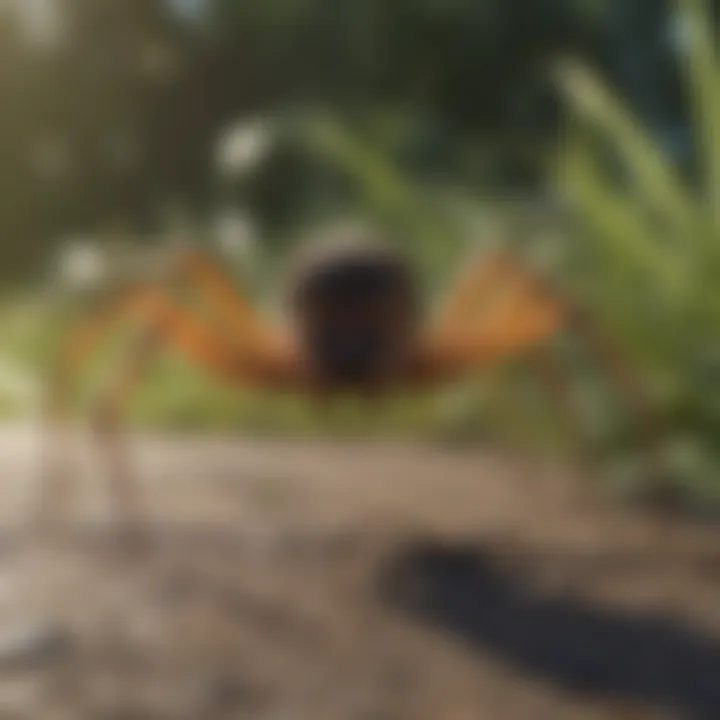Comprehensive Strategies for Effective Spider Control


Intro
Understanding the Role of Spiders in Ecosystems
Spiders play a crucial role in maintaining the balance of ecosystems. Their presence affects not only the populations of other insects but also influences the overall health of the environment. In this section, we cover key aspects that explain why understanding the role of spiders is essential for effective spider control strategies.
Spiders as Natural Pest Controllers
Spiders are often misunderstood and viewed as mere pests themselves. However, they serve a significant purpose as natural predators. A single spider can catch numerous insects, thus reducing the populations of common household pests such as flies, mosquitoes, and roaches. This predatory behavior aids in maintaining biological control. When spiders thrive in an environment, they help regulate pest populations, leading to less reliance on chemical pesticides. This creates a more sustainable approach to pest control that is eco-friendly.
By allowing spiders to coexist in controlled environments, homeowners can benefit from natural pest management without harming local ecosystems.
Biodiversity and Spider Populations
The biodiversity of spider populations is another point to consider. Spiders contribute to a rich tapestry of life, forming integral parts of the food web. Their diversity means they have various roles and adaptations that benefit ecosystems in different ways. Some spiders build webs, while others actively hunt, ensuring a diverse method of prey capture and population control.
Healthier spider populations are indicators of a well-functioning ecosystem. Declines in their numbers can signal environmental issues such as habitat destruction or pollution. This is why conservation efforts aimed at protecting spider habitats are important. Ignoring the role of spiders in biodiversity may lead to unforeseen consequences in pest management and ecological imbalance.
In summary, understanding the role of spiders in ecosystems is vital for implementing effective strategies in spider control. Their contributions as natural pest controllers and their significance in biodiversity provide a foundation for thoughtful and environmentally friendly pest management approaches.
Identifying Common Household Spiders
Identifying common household spiders is crucial for effective management and control. Understanding the species that inhabit your home can significantly influence the strategies you choose for dealing with them. Spiders play various roles in the ecosystem, and not all species pose the same level of threat or discomfort. Thus, different approaches and responses may be warranted based on spider identification.
Familiarity with common household spiders enables homeowners to make informed decisions about control measures. This knowledge is also essential in distinguishing benign species from those that might be harmful or nuisance-causing. Being able to identify these spiders reduces unnecessary fear and promotes a rational response to their presence.
Appearance and Behavior of Common Species
Several spider species frequently invade homes, each with unique appearances and behaviors. For instance, the common house spider can be recognized by its grayish or brownish body and typically small size. On the other hand, the black widow, known for its glossy black body and red hourglass marking, is easily identifiable but less commonly found in households compared to more innocuous species. An understanding of these traits can facilitate quick identification.
Common behaviors also vary. House spiders tend to weave irregular webs in corners, while wolf spiders are more active hunters and do not spin webs. Recognizing these patterns can assist homeowners in managing their presence more effectively. When you understand what type of spider you are dealing with, it becomes easier to decide whether action is necessary or not.
Potential Risks and Benefits
Understanding the potential risks and benefits associated with common household spiders aids in effective spider management. Some spiders, like the black widow or brown recluse, can bite and their venom can cause serious health issues. Therefore, knowing how to identify these types is vital for personal safety.
On the positive side, many spiders serve as natural pest controllers by preying on insects like flies and mosquitoes. This natural pest control can reduce the overall number of pests in the home without the need for chemical interventions.
In summary, a comprehensive understanding of both risks and benefits encourages a balanced perspective on spider presence in homes. Homeowners are advised to assess the species before determining which methods of control, if any, should be applied.
Proper identification of household spiders can mitigate fear, allowing for better management and appreciation of their ecological roles.
Chemical Control Measures
When addressing spider infestations, chemical control measures play a significant role in managing the situation effectively. These measures are frequently utilized for their quick action and efficiency against a variety of pests, including spiders. It is crucial, however, to choose the correct products and understand their application methods to minimize risks to humans and pets.
The use of insecticides specifically designed for spiders can reduce the overall spider population in domestic settings. One benefit of chemical pest control is its ability to provide immediate results. Homeowners facing a severe spider problem may find that chemical solutions allow for rapid relief from the discomfort these creatures may cause. Moreover, these products can often access areas that are hard to reach, ensuring comprehensive coverage. However, it is imperative to consider the ecological impacts.
Insecticides can affect non-target species, including beneficial insects. Therefore, understanding when and where to apply these chemicals is imperative. Proper usage can help control spiders without unduly harming the environment.
Insecticides: Types and Application
Insecticides for spider control come in varied types, each with specific formulations and purposes. There are both contact insecticides and residual insecticides.
- Contact Insecticides: These are designed to kill insects upon direct contact. Sprays are commonly used here as they offer immediate effectiveness. However, they usually have a short lifespan and may require repeated applications.
- Residual Insecticides: These products can persist longer. They remain active on surfaces for extended periods, allowing for ongoing protection as spiders crawl across treated areas. Common commercial brands include Ortho Home Defense and Raid Max Spider Killer, which can be found in many retail locations.
When applying insecticides, always read and follow the label instructions. It includes details on how much to use, where to apply, and safety precautions. Ensure that you treat areas frequently accessed by spiders, such as corners, window frames, and under furniture.
"Understanding the correct application methods can greatly enhance the effectiveness of chemical control measures while ensuring safety."
Safety Precautions When Using Chemicals
Using chemical insecticides comes with certain risks, especially in homes with children and pets. Therefore, understanding safety precautions cannot be overstated. Below are essential points to remember:


- Read Labels: Always read the product label for safety instructions and application guidelines before use.
- Wear Protective Gear: It is advisable to wear gloves and a mask while applying chemicals to avoid skin contact and inhalation.
- Ventilate Spaces: Ensure proper ventilation during and after application. Open windows and doors can help reduce exposure to chemical fumes.
- Store Safely: Keep all chemicals stored in a secure place, away from children and pets.
- Avoid Overuse: Using excessive amounts of product may not only be wasteful but can also lead to increased risk of harm. Stick to recommended amounts.
The effectiveness of chemical control is tied to the responsible use of these products. By taking the necessary precautions, homeowners can mitigate risks while managing spider populations.
Non-Chemical Control Methods
Non-chemical control methods play a significant role in managing spider populations in various environments. As awareness of ecological impacts grows, more homeowners prefer approaches that minimize harm to beneficial species, including spiders. Relying on these methods allows for a balanced ecosystem while effectively reducing spider presence. A strategy devoid of harsh chemicals can often be safer for children, pets, and the vegetation surrounding your home.
The benefits of non-chemical methods extend beyond mere spider control; they encourage a more holistic approach to pest management. When considering these strategies, it's essential to think about their practicality and efficiency in addressing spider issues while promoting an environment that fosters both human and ecological health.
Physical Barriers and Traps
Physical barriers and traps are direct methods of controlling spider populations without using pesticides. These methods are quite effective and can serve as a first line of defense. Common forms of physical barriers include screens on windows, door sweeps, and sealants for cracks and crevices in walls.
Using traps can also be beneficial. Sticky traps placed in spider-prone areas can catch spiders and help monitor their presence. However, it’s important to position these traps strategically, as spiders tend to frequent specific zones like corners or behind furniture.
Considerations for setting up barriers:
- Install screens: Ensure that all windows and vents are properly screened.
- Seal openings: Look for tiny gaps where spiders can enter and seal them with caulking.
- Regularly inspect: Assess physical barriers for wear and gaps periodically to maintain their effectiveness.
By implementing these measures, you can significantly deter spiders from entering your home.
Natural Predators and Eco-Friendly Solutions
Engaging natural predators and eco-friendly solutions is another excellent non-chemical approach to spider control. This involves leveraging the natural balance of the ecosystem to manage unwanted spider populations. For instance, attracting birds, which are natural predators of spiders, can help keep their populations in check.
Additionally, using plants known to repel spiders, such as lavender or peppermint, can act as a natural deterrent. Maintaining a garden of these plants not only aids in spider management but also enhances the aesthetic value of your outdoor space.
Consider the following eco-friendly solutions:
- Encourage birds: Install birdhouses or feeders to attract species that eat spiders.
- Plant repellents: Grow lavender, mint, or eucalyptus around your home.
- Use essential oils: Mixing essential oils, such as tea tree or citrus oil, with water in a spray bottle can create a natural repelent to apply around the perimeter of the home.
Integrating natural methods not only helps in controlling spider populations but also promotes biodiversity and a healthier environment.
Integrated Pest Management (IPM) Strategies
Integrated Pest Management, commonly known as IPM, is an ecological approach that combines various strategies to control pests, including spiders. This method is crucial for effective spider control because it emphasizes understanding pest behavior and the ecosystem. By using multiple strategies, IPM minimizes reliance on chemical pesticides, promoting a more sustainable method of pest management. The balance it seeks is not just about reducing spider populations, but also about maintaining the natural environment's health.
What is Integrated Pest Management?
IPM is a holistic approach to pest control that relies on a combination of techniques. It involves understanding the life cycles and behaviors of pests, including spiders. The concept includes several key elements:
- Monitoring: Regularly inspecting the environment for spider activity. This helps in determining if spider populations are at a level that requires action.
- Prevention: Implementing measures to deter spiders from entering homes. This can include sealing cracks and gaps and modifying the landscape around the property.
- Control: When intervention is needed, IPM employs various strategies ranging from biological controls, such as introducing natural predators, to the careful application of insecticides as a last resort.
These elements work together to create an adaptive management plan that can evolve based on observed outcomes and changing conditions. The emphasis is on long-term solutions rather than quick fixes.
Implementing IPM for Spider Control
To effectively implement IPM for spider control, follow these steps:
- Surveying the Area: Conduct thorough inspections to identify spider hiding spots. Pay attention to corners, window frames, and dark spaces.
- Identifying Species: Different species may require different management strategies. Knowing whether you are dealing with house spiders, cellar spiders, or more harmful varieties is essential.
- Utilizing Non-Chemical Methods First: Before using pesticides, focus on non-chemical methods as a preventive measure. This may include:
- Monitoring and Evaluation: After implementing various strategies, keep track of spider populations. Adjust your methods based on the effectiveness observed.
- Educating Household Members: Everyone in the home should understand the importance of IPM and how their actions can affect spider populations. Encourage them to keep spaces tidy and report any unusual spider sightings.
- Physical Removal: Use a vacuum or broom to remove visible spiders and webs.
- Natural Deterrents: Essential oils like peppermint or vinegar can deter spiders.
By adhering to these steps, homeowners can achieve a sustainable approach to spider control that aligns with ecological principles. Always remember that the goal of IPM is not the total elimination of spiders but rather the management of their populations within a tolerable level.
Preventive Measures for Spider Control
Effective spider control begins with preventive measures. These strategies are essential for minimizing the likelihood of spider infestations in homes and other environments. By implementing these practices, homeowners can create less hospitable conditions for spiders, breaking the pest cycle before it begins. The advantages include reduced use of chemical treatments, less stress around potential bites, and an overall improvement in household hygiene.
Environmental Adjustments and Habitat Modification
Altering the environment can significantly impact spider populations. First, consider the landscaping around your property. Overgrown bushes and tall grass can provide perfect hiding spots. Trim these areas and remove any debris or clutter, such as piles of wood or leaves. Spiders are less likely to thrive when their living conditions are less favorable.
Another key step is sealing cracks and openings around the home. Spiders often enter through these gaps. Inspect window screens, doors, and utility lines for any gaps. Sealing these can prevent access points. Appropriate ventilation will also help to keep areas dri and reduce humidity, making them less appealing to spiders.


In addition, consider evaluating indoor plants or decorations. Certain plants can attract more spiders, so it may be wise to choose non-attractive species. Placing plants away from windows can also help.
Maintaining Clean and Clutter-Free Spaces
A clean environment is crucial in deterring spider infestations. Regular cleaning routines should focus on not just visible surfaces, but also areas that often get overlooked. Dusting and vacuuming are essential practices. Pay special attention to corners, baseboards, and under furniture where webs and egg sacs can go unnoticed.
Moreover, minimizing clutter can reduce hiding spots. This includes piles of newspapers, laundry, or items stored in closets. A more organized space means fewer places for spiders to hide and breed.
Homeowner Practices for Spider Management
Homeowner practices for spider management are crucial in maintaining a pest-free environment. This section focuses on practical strategies that can be performed by homeowners to minimize spider populations in their homes while ensuring a balanced ecosystem. Adopting these practices can provide numerous benefits, including reducing the risk of unwanted encounters and promoting a cleaner living space. Homeowners should recognize the significance of being proactive in addressing spider issues rather than waiting for infestations to occur.
Regular Inspections and Monitoring
Regular inspections and monitoring are vital to effective spider management. This practice involves systematically checking common spider habitats within the home, such as corners, basements, and closets. Homeowners should look for signs of spider webs or egg sacs, as these indicators often point to a developing population.
Benefits of regular inspections include:
- Early Detection: Identifying spiders early can prevent larger infestations.
- Targeted Treatment: Knowing where spiders frequent allows for targeted pest control measures.
- Raising Awareness: Regular checks create a habit of being mindful about one’s surroundings, increasing overall vigilance against pests.
To implement this practice, set a fixed schedule for inspections, perhaps once a month. Make notes of findings, which can aid in tracking changes over time. If spiders are spotted, it can be useful to identify their species to address any potential risks they might pose.
Educating Family Members about Spiders
Educating family members about spiders is another important aspect of effective spider management. Understanding spider behavior and their role in the ecosystem helps to reduce fear and foster a more positive view of these creatures. Knowledge about spiders can also empower family members to act appropriately if they encounter one.
Key components of education include:
- Understanding Species: Teaching family members how to identify common household spiders can demystify their presence.
- Behavior Awareness: Learning about the harmless nature of most household spiders may lessen fears and encourage a more tolerant attitude.
- Safe Removal Techniques: Educating on safe ways to capture and release spiders, rather than killing them, promotes humane practices.
Families can organize casual discussions or use flyers and educational videos to enhance understanding. Frequent conversations can solidify the learning and ensure everyone, including children, feels comfortable managing their encounters with spiders.
"By educating those in your household, you can cultivate a cooperative approach to pest management that benefits everyone involved."
The Importance of Education in Pest Control
Education plays a crucial role in the effective management of spider populations within homes and other environments. Understanding spiders, their behavior, and their life cycles enables homeowners to make informed decisions regarding pest control methods. This knowledge empowers individuals to appreciate the ecological significance of spiders rather than simply viewing them as pests.
An educated approach facilitates the balance between controlling unwanted spider presence and preserving beneficial species. Insects like spiders contribute to natural pest control by preying on other insects. Recognizing this intrinsic value helps in developing strategies that are both effective and environmentally responsible.
Key considerations for education in pest management include:
- Understanding Spider Behavior: Knowing when and where spiders tend to appear can guide preventive measures. Education helps individuals identify which spiders are harmless and which may pose risks, aiding in effective decision-making.
- Lifecycle Awareness: Familiarity with spider lifecycles enhances the timing of control measures. For example, understanding breeding seasons can lead to targeted interventions during peak times.
- Safe Practices: Knowledge about proper handling of chemicals and the importance of choosing eco-friendly options can help minimize adverse impacts on the environment and human health.
"An informed homeowner is more likely to adopt integrated pest management strategies that lead to enduring solutions rather than temporary fixes."
By actively engaging in educational opportunities, such as local workshops or online resources, homeowners can acquire valuable insights about spider control, fostering a proactive rather than reactive stance in managing their spaces.
In the pursuit of effective spider management, education forms the foundation for sustainable practices, allowing communities to thrive in balance with nature.
Case Studies in Spider Control
Case studies in spider control provide insightful examples of how different strategies are implemented in various environments. This section illustrates real-world scenarios, showing the effectiveness of methods that balance both efficiency and ecological considerations. By examining these cases, homeowners can better understand which techniques are most applicable to their situations.
Successful Implementations of IPM
Integrated Pest Management, or IPM, represents a synergistic approach to pest control. It involves combining multiple strategies, such as biological, cultural, mechanical, and chemical, tailored to the specific pest problem.
Case studies such as those from the University of Florida highlight successful IPM applications in residential areas. For instance, one community faced significant spider infestations linked to overgrown vegetation. Homeowners collaborated with pest control professionals to trim vegetation, ensuring better airflow and sunlight exposure, which makes environments less appealing to spiders.
In another instance, a homeowner reported success after implementing essential changes recommended by local pest management experts. Sealing gaps in windows and doors, along with regular cleaning, drastically reduced spider sightings. These approaches emphasize the role of environment management in spider control and illustrate the effectiveness of IPM principles applied in residential settings, enhancing the overall livability without solely relying on chemical solutions.
Lessons Learned from Various Environments
Analysing different environments reveals diverse strategies in spider management. From urban to rural contexts, each setting presents unique challenges and solutions.


For example, a study conducted in a suburban neighborhood indicated that community involvement played a crucial role. Residents formed groups to share knowledge about spider species and control methods. This collective effort not only reduced spider populations but also fostered an understanding of their ecological role.
In contrast, urban areas often encounter issues with larger spider populations due to the availability of food sources and nesting sites in buildings. Lessons learned here include the importance of ongoing education for residents regarding spider lifecycle and behaviors. Simple actions, such as removing food sources and clutter, have proven effective in these tightly packed communities.
By learning from these varied experiences, homeowners can apply proven strategies to their living spaces, adopting practices that reflect the specific challenges faced in their environments.
Evaluating the Effectiveness of Spider Control Measures
Evaluating the effectiveness of spider control measures is crucial in understanding which methods yield the best results. This evaluation not only helps determine success rates but also reveals potential areas for improvement in methodologies employed by homeowners and pest control professionals alike. When spiders infest an area, it can lead to discomfort and the perception of unsanitary conditions. Thus, a systematic evaluation ensures that control measures are both effective and safe for the environment.
Monitoring the effectiveness of various spider control strategies provides insights into their impact on spider populations and the overall ecosystem. By assessing outcomes, individuals can make more informed decisions on whether to continue, adjust, or replace their spider control tactics. Different approaches may be necessary based on the effectiveness observed during this process.
Furthermore, evaluating chemically based methods versus non-chemical alternatives allows for a balanced assessment of their ecological implications. Residents can weigh the benefits of immediate results against the long-term sustainability of their environment. Overall, this analysis plays a vital role in optimizing spider control practices across various settings.
Monitoring Outcomes and Adjustments
Monitoring outcomes after implementing spider control strategies is essential to discern their effectiveness. Homeowners should keep track of spider sightings over time, noting any changes in behavior or population levels. Simple tools such as journals or apps can be used to log these observations, helping to create a clearer picture of the situation.
After monitoring, adjustments may need to be made. If a specific method is less effective than expected, alternatives should be considered. Homeowners might need to increase the frequency of application for chemical treatments or explore more physical barriers if non-chemical methods fail.
Also, continuous evaluation helps to identify any emerging issues. For instance, if certain spider species continue to persist despite interventions, this may indicate resistance or a need for a different approach. Adapting techniques based on real-time information ensures that spider control remains effective and relevant.
Feedback from Homeowners and Professionals
Feedback from homeowners and professionals can provide valuable insights into the effectiveness of spider control measures. Homeowners often have hands-on experience with various techniques, ranging from chemical sprays to natural deterrents. Gathering their testimonials can highlight what worked well and what might not be practical.
Professionals, on the other hand, may provide a broader understanding based on their experience with multiple clients and situations. They can offer perspectives on common pitfalls, successful strategies, and innovative solutions that homeowners might not have considered.
Collecting feedback through surveys, online forums, or community groups enhances the wealth of knowledge available. This collective wisdom helps in developing more effective protocols and guidelines for spider management.
Future Directions in Spider Management
Understanding future directions in spider management is crucial for homeowners and pest control professionals alike. This topic encompasses advancements in technology and evolving practices that promote more effective, sustainable approaches to managing spider populations. As we navigate the complexities of pest control, awareness of these future trends is essential for implementing strategies that are both compelling and environmentally responsible.
Emerging Technologies in Pest Control
Advanced technologies are paving the way for more effective methods in spider control. Innovations such as smart traps, which utilize sensors to detect spider activity, are becoming increasingly popular. These traps can alert homeowners via smartphone notifications, providing real-time data on spider populations. This aids in making informed decisions about control measures based on actual activity rather than assumptions.
In addition to smart traps, the development of pheromone-based monitoring systems is gaining traction. These systems attract spiders and can help identify infestation levels in a given area. Such early detection systems can significantly reduce the need for widespread chemical applications.
Moreover, robotic solutions are beginning to emerge. Automated pest control devices can patrol spaces for unwanted pests, including spiders, offering a non-invasive control approach. These technologies not only enhance efficiency but also have the potential to minimize environmental impact compared to traditional means of pest control.
Trends in Eco-Friendly Practices
As society becomes increasingly aware of environmental concerns, eco-friendly practices in spider management are gaining prominence. Homeowners are leaning towards more sustainable approaches that do not disrupt the existing ecosystem. One effective method is to encourage natural predators of spiders, such as certain bird species, which can help control spider populations naturally.
Another trend is the use of botanical insecticides, derived from plant extracts. These substances tend to be less harmful to beneficial insects and the environment as a whole. They offer an alternative solution that, while effective against spiders, still aligns with eco-conscious practices.
Educating homeowners about the importance of maintaining a balanced ecosystem has also become a focal point. Understanding the role spiders play in controlling other pest populations guides people toward more thoughtful, less reactionary management tactics. This education in eco-friendly practices can lead to more informed decisions about when and how to intervene.
The future of spider management rests on the balance of effective control and environmental responsibility.
As we look ahead, it is evident that integrating emerging technologies with eco-friendly practices will create more effective and sustainable solutions for spider management, catering to the needs of both homeowners and the environment.
End on Effective Spider Management
Effective spider management is essential in maintaining a balanced ecosystem while addressing household needs. This section summarizes the insights presented in this article and emphasizes strategies that achieve both pest control and ecological harmony. It is important to recognize that spiders, despite any discomfort they may cause, play an invaluable role in managing pest populations. Therefore, a multi-faceted approach is advisable.
Summarizing Key Points
- Understanding Spiders: Knowing the ecological roles of spiders provides a foundation for making informed decisions. They serve as natural pest controllers, which aids in minimizing other pest insects.
- Control Methods: Both chemical and non-chemical methods are discussed, including insecticides, physical barriers, traps, and natural predators. Each method has its benefits and limitations, making them suitable for various contexts.
- Integrated Pest Management (IPM): Implementing an IPM approach ensures a holistic strategy that considers environmental impact and personal safety. It involves monitoring, education, and adapting strategies based on feedback.
- Preventive Measures: Practicing preventive measures is crucial. Maintaining cleanliness, modifying environments, and educating household members reduce the likelihood of spider infestations.
The combination of these strategies forms a comprehensive framework for effectively managing spider populations while minimizing negative impacts.
Encouragement for Continued Learning
The landscape of spider control is continually evolving. Emerging technologies and new research provide ongoing insights into effective management practices. Homeowners are encouraged to remain vigilant and open to learning about spiders and effective control methods.
- Explore Resources: Online resources such as Wikipedia and Britannica provide valuable information on spider biology and ecology.
- Stay Informed: Participating in community discussions on platforms like Reddit can also help homeowners learn from shared experiences regarding spider management.
- Engagement: Encourage family discussions about spiders, including their benefits and safety precautions.
By fostering an informed mindset, homeowners contribute to a healthier balance between human habitation and the natural ecosystem, promoting a sustainable environment for all.







